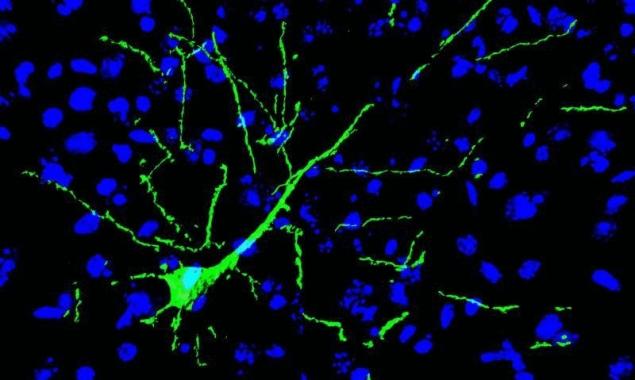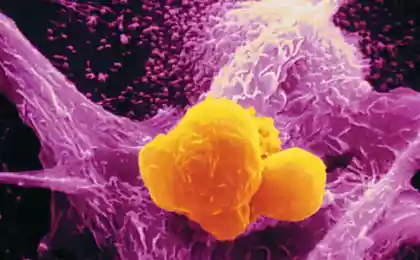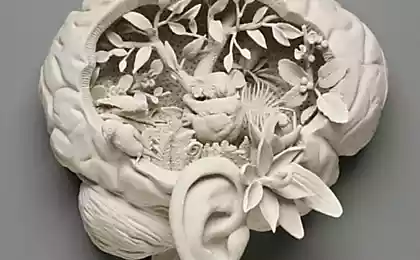528
Transplanted nerve cells integrated into the brain
New nerve cells from skin cells, and the neurons with such a peculiar origin after transplantation can take its place in brain neural circuits.

Cage-the predecessor neuron (green) among other nerve cells (whose nuclei colored blue).
Although the nerve cells is still being restored (in the brain areas where new neurons even in adulthood), this upgrade is clearly not enough to cover the mass death of cells, for example, in the case of Parkinson's disease. You can, of course, to do otherwise, and to grow the necessary number of neurons in the laboratory. You need to take some Mature cells, e.g. skin cells, to convert them to stolovoe condition, that is, to give them back the ability to turn into any other cell type, and to program on transformation into neurons. The resulting cells can be transplanted into the brain.
However, the neurons form a complex network, forming with each other a lot of contacts. Whether new neurons, transplanted from outside, inserted into the existing neural network, and whether they are in it to function? Check out this tried researchers from the University of Luxembourg: they have turned the skin cells of mice in a variety of stem cells, which are the direct precursors of neurons, and transplanted neural stem cells into the brain of the same mice in the hippocampus (one of the main centers of memory) and the cortex.
As the authors of the work in Stem Cell Reports, six months later any side effects in animals is not apparent. Moreover, neurons that were formed and matured from stem precursors, formed synapses with "indigenous" nerve cells and successfully became part of the nerve chain.
To clinical trials there are still quite far away – yet managed to show is that the transplanted nerve cells, and even obtained from skin cells do not remain in the brain by themselves and in principle can generate receive and transmit signals to other cells. Now have to figure out how they do it: although in mice, as has been said, side effects were not, the performance of the new neurons need to repeatedly check back. For example, it would be good to make sure new nerve cells, standing in the right place can replace the neurons that produce dopamine. If Yes, thus it will be possible to compensate for the symptoms of Parkinson's disease, which are primarily killed just dopamine nerve cells. But again, in practice it is a question of very distant future.
Source: nkj.ru

Cage-the predecessor neuron (green) among other nerve cells (whose nuclei colored blue).
Although the nerve cells is still being restored (in the brain areas where new neurons even in adulthood), this upgrade is clearly not enough to cover the mass death of cells, for example, in the case of Parkinson's disease. You can, of course, to do otherwise, and to grow the necessary number of neurons in the laboratory. You need to take some Mature cells, e.g. skin cells, to convert them to stolovoe condition, that is, to give them back the ability to turn into any other cell type, and to program on transformation into neurons. The resulting cells can be transplanted into the brain.
However, the neurons form a complex network, forming with each other a lot of contacts. Whether new neurons, transplanted from outside, inserted into the existing neural network, and whether they are in it to function? Check out this tried researchers from the University of Luxembourg: they have turned the skin cells of mice in a variety of stem cells, which are the direct precursors of neurons, and transplanted neural stem cells into the brain of the same mice in the hippocampus (one of the main centers of memory) and the cortex.
As the authors of the work in Stem Cell Reports, six months later any side effects in animals is not apparent. Moreover, neurons that were formed and matured from stem precursors, formed synapses with "indigenous" nerve cells and successfully became part of the nerve chain.
To clinical trials there are still quite far away – yet managed to show is that the transplanted nerve cells, and even obtained from skin cells do not remain in the brain by themselves and in principle can generate receive and transmit signals to other cells. Now have to figure out how they do it: although in mice, as has been said, side effects were not, the performance of the new neurons need to repeatedly check back. For example, it would be good to make sure new nerve cells, standing in the right place can replace the neurons that produce dopamine. If Yes, thus it will be possible to compensate for the symptoms of Parkinson's disease, which are primarily killed just dopamine nerve cells. But again, in practice it is a question of very distant future.
Source: nkj.ru























